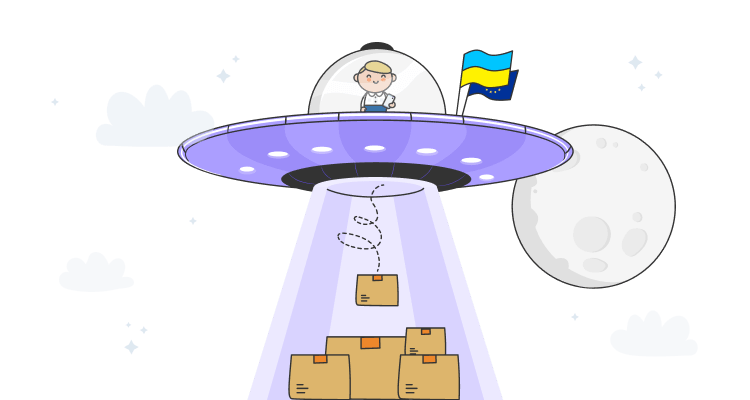The introduction of the eTTN (electronic bill of lading) in Ukraine will have a significant impact on all business sectors involved in the transportation of goods. The business is currently waiting for the approval of the eTTN status in the Law of Ukraine “On Road Transport”. The draft amendments to the law are intended to regulate controversial issues related to the functioning of the electronic bill of lading.
Although the mandatory transition to electronic bills of lading is likely to be postponed with the extension of martial law, businesses need time to get prepared.
The retail sector, in particular, is expected to see significant changes. To understand how electronic TTNs will affect the operation of retail chains, let’s consider the ways that bills of lading are used in the supply of goods.
What documents support the supply chain?
A bill of lading is one of the primary documents that supports supply chains. The content and form of such documents are determined by the Law of Ukraine “On Accounting and Financial Reporting in Ukraine” and the Regulation on Documentary Support of Accounting Records, approved by Order of the Ministry of Finance No. 88 dated May 24, 1995.
According to Regulation No. 88, primary documents are documents created in written or electronic form that contain information about business transactions, including orders and permissions of the administration (owner) to perform them. In addition to TTNs, they may include goods delivery notes, goods receipt notes and other invoices, statements of performed work, cash receipt and cash payment orders, and other documents.
In modern retail practice, several document workflow schemes have been distinguished, according to which retail chains supply goods. They are typically based on a goods receipt note, a goods delivery note, or a combination of the two.
While a goods delivery note or goods receipt note certify the ownership of the goods, a paper or electronic TTN confirms compliance with all regulations regarding their transportation. In other words, the TTN proves that the driver is transporting the goods legally, following a specified route, complying with all regulations regarding vehicle loading, etc.

How does eTTN fit into supply chain schemes?
The electronic TTN has a strict signing procedure (cargo consignor – driver – cargo consignee). This logic contradicts schemes where the chain generates a receipt note at the time the goods are received.
Besides, combined schemes involving both goods delivery and receipt notes are based on a different logic. For instance, this is how deliveries in the Prostor chain are organized. The supplier has two options for drafting primary documents: a goods receipt note from the chain, or a delivery note created by the supplier and signed by the chain after comparing it with the goods receipt note.
In such cases, the processes of entering the goods into the books and registering the transportation are asynchronous. This complicates the process of supplying goods.
This problem does not exist in schemes using a goods delivery note. The supplier creates the delivery note and also acts as the sender of the goods. However, in this case, the participants in the supply process face the problem of duplication of information in both documents. This situation has developed because there were no standards for document flow in retail in Ukraine for a long time. And the introduction of eTTN will be one of the steps needed for standardization in this area.
Will eTTN reform the Ukrainian retail industry?
The implementation of eTTN in Ukraine is focused on the standards of the European Union, where the document workflow system in the supply of goods is extremely simplified. Currently, European countries use the e-CMR document during transportation, which contains all the information necessary for the participants in the supply process.
Therefore, with the introduction of eTTN in Ukraine, we can expect both a unified document standard and an optimal supply chain. In the current retail market conditions, we believe that this scheme is based on the goods delivery note.
With the transition to the eTTN, retailers will have to adjust their already streamlined processes to meet the new requirements. This will require analyzing all actions that need to be documented, the routes of all documents, the procedure for their signing, the list of responsible signatories, etc.
After switching to the eTTN, one of the challenges for retailers will be to convert other documents accompanying deliveries into electronic format. Most retailers already use EDI services for this purpose. They can be used to generate supporting documents for the eTTN.

Reasons for implementing eTTN and challenges that may be faced
Vchasno.EDI clients talk about the benefits of switching to an electronic bill of lading and the difficulties retailers may face on the way.
Oleg Chubarenko, director of the legal department at ROST supermarket chain, notes that the introduction of the electronic TTN can help to streamline supply chains:
To implement eTTN, the chain needs to refine its own accounting system and agree with the provider. Once it is done, the electronic document workflow would run at full capacity. There is no problem generating a delivery note when you have a TTN from the supplier. Thus, the supplier generates an eTTN and a delivery note and sends them to the buyer. If you organize such a document workflow scheme “from the supplier”, you can cover 95% of the retail market.
Sergii Halasa, IT director of the UltraMarket chain, points out that in order to work with eTTN, it is important that the chain transfers all other documentation related to the supply of goods into electronic format:
The eTTN implies that all supporting documents are already automated. Otherwise, it will take an unreasonable amount of time to reconcile the eTTN with paper documents.
Yuliia Krasilnikova, Director of Chain Development at UA LLC Euromix, recognizes possible difficulties in correcting data in e-documents:
An important thing is how the market will be responding to the need of adjusting documents, in particular, notes. How will this be reflected in the eTTN? It is crucial to properly organize the work with the statements of adjustment to the eTTN so that e-documents would reflect the correct data.
Hence, we can expect the introduction of eTTNs to have a positive impact on Ukrainian retail, particularly by bringing supply processes and supporting documentation to a single standard. Therefore, retail chains should prepare for the innovation right now to make the transition to electronic TTNs smooth.







